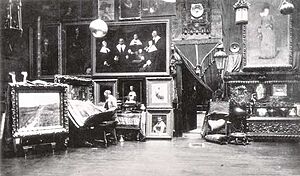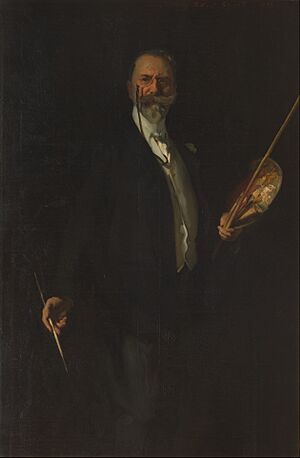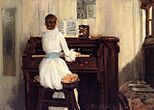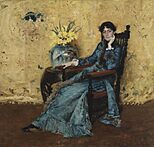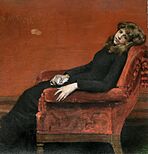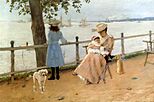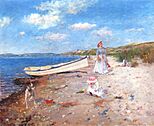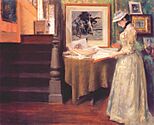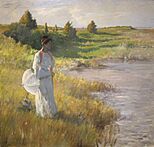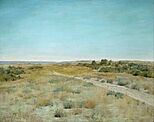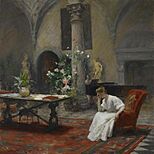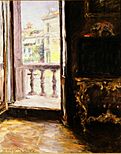William Merritt Chase facts for kids
Quick facts for kids
William Merritt Chase
|
|
|---|---|
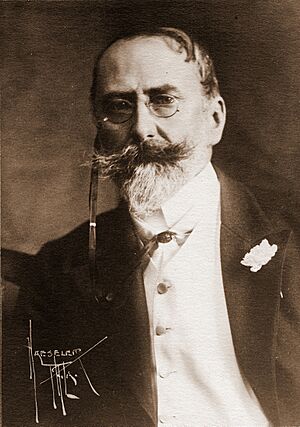
Chase in 1900
|
|
| Born | November 1, 1849 Nineveh, Indiana, US
|
| Died | October 25, 1916 (aged 66) New York City, US
|
| Education | National Academy of Design; Academy of Fine Arts, Munich, |
| Known for | Portrait painting; landscape art |
| Movement | Impressionism |
| Awards | Philadelphia Centennial Exposition medal |
William Merritt Chase (born November 1, 1849 – died October 25, 1916) was an important American painter. He was known for his Impressionism style and for being a great teacher. He even started a famous art school, which is now called the Parsons School of Design.
Contents
Early Life and Art Training
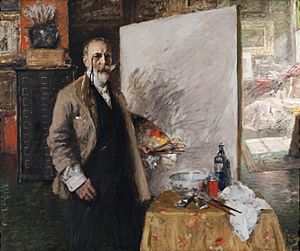
William Merritt Chase was born on November 1, 1849, in Williamsburg, Indiana. This town is now called Nineveh. His parents were Sarah Swain and David H. Chase, a local businessman. In 1861, his family moved to Indianapolis. William helped his father with the family business there.
From a young age, Chase loved art. He studied with local artists Barton S. Hays and Jacob Cox. When he was 19, Chase tried being a sailor for a short time. But he soon realized art was his true passion. His teachers encouraged him to go to New York to learn more about art.
He arrived in New York in 1869. He studied briefly with Joseph Oriel Eaton. Then, he joined the National Academy of Design. There, he learned from Lemuel Wilmarth, who was a student of the famous French artist Jean-Léon Gérôme.
In 1870, his family faced money problems. Chase had to leave New York and move to St. Louis, Missouri, where his family was living. He worked to help support them. He also became active in the St. Louis art scene. He won awards for his paintings at a local show. In 1871, he showed his first painting at the National Academy.
Wealthy art collectors in St. Louis noticed his talent. They helped him go to Europe for two years. In return, Chase would paint for them and help them find European art.
Studying Art in Europe
In Europe, Chase went to the Academy of Fine Arts, Munich. This was a well-known art school. Many Americans were going there to study. Chase liked it because it had fewer distractions than Paris. He studied with Alexander von Wagner and Karl von Piloty. He also became friends with American artists like Walter Shirlaw, Frank Duveneck, and J. Frank Currier.
In Munich, Chase mostly painted people. He used a loose, brushy style that his teachers liked. In 1876, one of his portraits, "Keying Up" – The Court Jester, was shown in Boston. Later that year, it won a medal at the Philadelphia Centennial Exposition. This success made Chase famous for the first time.
Chase traveled to Venice, Italy in 1877 with Duveneck and John Henry Twachtman. He returned to the United States in 1878. He was now a very skilled artist. He was part of a new group of American artists who had studied in Europe.
Back in America, he showed his painting Ready for the Ride in 1878. He also opened a studio in New York. It was in the Tenth Street Studio Building, where many important painters worked. He was part of a group called the Tilers. This group included artists and writers like Winslow Homer and Augustus Saint Gaudens.
In 1881, his friend and artist William Preston Phelps went back to Europe. They traveled together, visiting Italy, Venice, Capri, and Germany.
Chase's Life as an Artist and Teacher
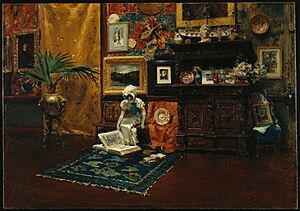
William Merritt Chase was many things: a stylish city person, a loving family man, and a respected teacher. In 1887, Chase married Alice Gerson. They had eight children. His oldest daughters, Alice and Dorothy, often posed for his paintings.
In New York City, Chase was known for his fancy style. He dressed very well and had a grand studio. He moved into Albert Bierstadt's old studio on Tenth Street. Chase decorated it with beautiful furniture, art objects, stuffed birds, and fancy carpets. His studio was a popular place for artists and fashionable people in New York. By 1895, it cost too much to keep the studio. Chase had to close it and sell everything inside.
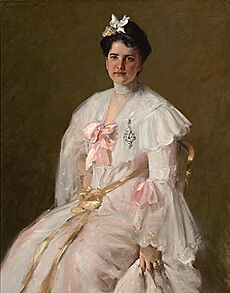
Besides painting, Chase loved to teach. He started by teaching private students. One of his first students was Dora Wheeler. She became a professional artist and a lifelong friend. Dora's mother, Candace Wheeler, said Chase was a very giving teacher. He shared his knowledge and encouraged his students.
In 1891, Chase opened the Shinnecock Hills Summer School of Art on Long Island, New York. He taught there until 1902. Chase taught his students to paint outdoors, using the plein air method. He also opened the Chase School of Art in 1896. This school later became the New York School of Art. Chase continued teaching there until 1907.
He also taught at other famous art schools. These included the Pennsylvania Academy of the Fine Arts and the Art Students League. Chase was one of the most important art teachers in America around 1900. Many famous artists learned from him. Some of his students were George Bellows, Charles Demuth, Marsden Hartley, and Georgia O'Keeffe. He also influenced artists in California and Texas.
European Summer Art Tours
After leaving Shinnecock Hills, Chase started taking groups of students to Europe in the summer. They would visit important art cities. In 1903, Chase and his students went to Haarlem in the Netherlands. There, Chase was inspired by a painting by Frans Hals. He painted a self-portrait of himself looking like one of Hals's figures.
Art Style and Subjects
Chase worked with many different art materials. He was best at oil painting and pastels. But he also made watercolor paintings and etchings. A writer named S.G.W. Benjamin described his style:
He used color beautifully in all his works. This was true whether he painted soft skin tones or strong red colors, like in his famous "Court Jester" painting. When painting a portrait, he tried to capture the person's true character. Sometimes his style was very impressionistic.
Painting Portraits
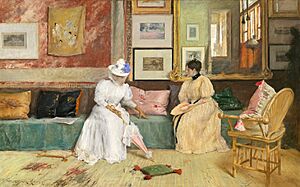
Chase is perhaps most famous for his portraits. He painted many important people of his time. His 1892 portrait of painter Lydia Field Emmet shows her in a strong pose. Her hand is on her hip, and she looks over her shoulder. This pose was often used for men in older paintings.
Chase also often painted his wife Alice and their children. Sometimes he painted individual portraits. Other times, he showed them in peaceful family scenes. They might be having breakfast in their yard or relaxing at their summer home on Long Island. The children would be playing on the floor or in the sand dunes. In an 1895 painting called A Friendly Call, his wife wears a yellow dress. She is talking with a visitor dressed in white.
Painting Landscapes
In the late 1880s, Chase started painting landscapes seriously. He may have been inspired by a big show of French Impressionist art in New York in 1886. Chase is best known for two types of landscapes, both painted in an Impressionist style. The first were his scenes of Prospect and Central Park in New York. The second were his summer landscapes at Shinnecock.
Chase often included people in his landscapes. He frequently showed women and children relaxing. They might be on a park bench, at the beach, or lying in the grass at Shinnecock. His Shinnecock paintings are seen as great examples of American Impressionism.
In 1903, Chase rented a villa near Florence, Italy. He returned there to paint each summer. Later, he bought another villa south of the city.
Painting Still Lifes
Chase painted still lifes throughout his career. He had done this since he was a student. His studios and homes were full of decorative objects. His indoor paintings often included still life elements. He was very good at showing how light looked on metal objects, like copper bowls.
Perhaps Chase's most famous still life subject was dead fish. He liked to paint them against dark backgrounds. They would look limp on a plate, as if fresh from the market. He was known for buying the fish, painting them quickly, and then returning them before they spoiled!
Awards and Later Career
Chase won many awards in America and other countries. He was a member of the National Academy of Design in New York. From 1885 to 1895, he was president of the Society of American Artists. He also joined the Ten American Painters group after John Henry Twachtman passed away.
As he got older, and as modern art became popular, Chase's creative work slowed down. But he kept painting and teaching into the 1910s. During this time, he taught young artists like Wilhelmina Weber Furlong and Edward Hopper.
In 1914, Chase taught his last summer class in Carmel-by-the-Sea, California. It was his largest class, with over one hundred students. He was very popular with his Carmel students. They wrote many descriptions of his lectures and teaching. Chase found the art community there a bit too small. He moved to a luxury hotel nearby.
William Merritt Chase passed away on October 25, 1916, at his home in New York City. He was seen as a respected elder in the American art world. He was buried in Green-Wood Cemetery in Brooklyn, New York.
Today, his paintings are in most major museums across the United States. His home and studio in Shinnecock Hills, New York, is now a historic landmark. It is called the William Merritt Chase Homestead.
Gallery
-
The Moorish Warrior, c. 1878. Brooklyn Museum.
-
The Young Orphan or At Her Ease, 1884, National Academy of Design, New York
-
Girl in a Japanese Costume, c. 1890. Brooklyn Museum
-
Study of a Girl in Japanese Dress c. 1895 Brooklyn Museum
See also
 In Spanish: William Merritt Chase para niños
In Spanish: William Merritt Chase para niños
- American Impressionism
- Belle Silveira
- List of William Merritt Chase artwork


